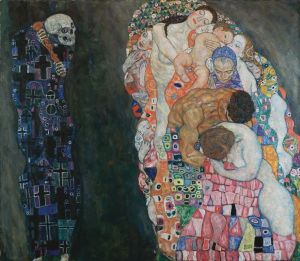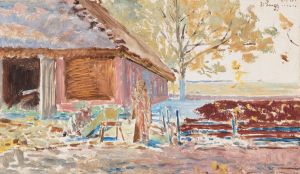
Smierc
A hand-painted replica of Jacek Malczewski’s masterpiece Smierc, meticulously crafted by professional artists to capture the true essence of the original. Each piece is created with museum-quality canvas and rare mineral pigments, carefully painted by experienced artists with delicate brushstrokes and rich, layered colors to perfectly recreate the texture of the original artwork. Unlike machine-printed reproductions, this hand-painted version brings the painting to life, infused with the artist’s emotions and skill in every stroke. Whether for personal collection or home decoration, it instantly elevates the artistic atmosphere of any space.
Jacek Malczewski, a prominent Polish painter associated with the Symbolist movement, created the painting "Śmierć" (translated as "Death") in the early 20th century. Malczewski is renowned for his unique style that blends Polish Romanticism with Symbolism, often exploring themes of national identity, mythology, and existential inquiry. "Śmierć" is one of his works that encapsulates these themes, reflecting his deep engagement with the philosophical and cultural issues of his time.
The painting "Śmierć" is emblematic of Malczewski's fascination with the concept of death, a recurring motif in his oeuvre. This work is characterized by its symbolic representation of death, which Malczewski often depicted not as a grim or terrifying figure but as a natural and integral part of the human experience. His portrayal of death is typically nuanced, inviting viewers to contemplate its role in the cycle of life and its impact on human consciousness.
Malczewski's use of color and composition in "Śmierć" is notable for its emotional depth and symbolic resonance. He often employed a muted palette, with somber tones that evoke a sense of introspection and melancholy. The figures in his paintings are frequently depicted in contemplative poses, surrounded by allegorical elements that enhance the thematic complexity of the work. In "Śmierć," these elements might include natural motifs such as flowers or landscapes, which serve to underscore the connection between life and death.
The cultural and historical context of Malczewski's work is crucial to understanding "Śmierć." During the time he was active, Poland was under partition, and national identity was a significant concern for Polish artists and intellectuals. Malczewski's art often reflects this preoccupation, using allegory and symbolism to comment on the Polish experience and the broader human condition. "Śmierć," like many of his works, can be seen as a meditation on the themes of mortality and the eternal struggle for meaning in a world marked by political and social upheaval.
Malczewski's influence extends beyond his thematic concerns; his technical skill and innovative approach to composition have left a lasting impact on Polish art. His ability to convey complex ideas through visual symbolism has earned him a place among the most important figures in Polish art history. "Śmierć" is a testament to his artistic vision, showcasing his ability to blend personal, national, and universal themes into a cohesive and thought-provoking work.
In summary, Jacek Malczewski's "Śmierć" is a significant piece within his body of work, reflecting his deep engagement with the themes of death, identity, and existential inquiry. Through its symbolic representation and emotional depth, the painting invites viewers to reflect on the nature of mortality and its place within the human experience. Malczewski's contribution to Polish art is marked by his unique ability to intertwine personal and national narratives, making "Śmierć" a poignant example of his artistic legacy.


















